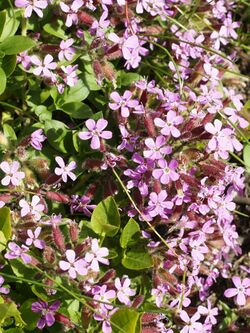Biology:Saponaria ocymoides
| Saponaria ocymoides | |
|---|---|

| |
| Scientific classification | |
| Kingdom: | Plantae |
| Clade: | Tracheophytes |
| Clade: | Angiosperms |
| Clade: | Eudicots |
| Order: | Caryophyllales |
| Family: | Caryophyllaceae |
| Genus: | Saponaria |
| Species: | S. ocymoides
|
| Binomial name | |
| Saponaria ocymoides | |
| Synonyms[1] | |
| |
Saponaria ocymoides, the rock soapwort[2] or tumbling Ted,[2] is a species of semi-evergreen perennial flowering plant belonging to the family Caryophyllaceae, native to south western and southern central Europe.[3]
Etymology
The Latin specific epithet ocymoides means “resembling basil” (Ocimum).[4] However the resemblance is superficial, as the two plants are not closely related. In fact Saponaria ocymoides belongs to the same family as pinks and carnations.
Description
Reaching a height of 10–40 centimetres (3.9–15.7 in), the stem is prostrate to ascending, woody, reddish, quite hairy and very branched. The leaves are ovate to lanceolate, sessile and hairy, 1–3 cm long. The five-petalled flowers are arranged in groups at the ends of branches. They have red or pink (rarely white) petals and blue anthers. The sepals are fused in a tube about an 8 to 10 millimeters long. The flowering period extends from May to August in the Northern Hemisphere. The fruit is an ovoid capsule, up to 9 mm long.
Distribution
This species ranges from the mountains of Spain to Corsica, Sardinia and Slovenia, from the Apennines to the Alps. It grows in rocky and stony places, dry slopes and forests (especially pine forests). It prefers calcareous (alkaline) soils, at an altitude of up to 1,500 metres (4,900 ft), rarely up to 2,400 metres (7,900 ft).
Cultivation
Saponaria ocymoides is cultivated as an ornamental plant for rock gardens and dry stone walls, in well-drained alkaline or neutral soil in full sun. Like most alpine plants it dislikes winter wetness around its roots.[3] It has gained the Royal Horticultural Society's Award of Garden Merit.[5][6]
Gallery
References
- ↑ "The Plant List: A Working List of All Plant Species". http://www.theplantlist.org/tpl/record/kew-2484913.
- ↑ 2.0 2.1 {{citation | mode = cs1 | title = Saponaria ocymoides | work = Germplasm Resources Information Network (GRIN) | url = | publisher = [[Organization:Agricultural Research ServAgricultural Research Service (ARS), United States Department of Agriculture (USDA) | access-date = 21 January 2018 }}
- ↑ 3.0 3.1 RHS A-Z encyclopedia of garden plants. United Kingdom: Dorling Kindersley. 2008. pp. 1136. ISBN 978-1405332965.
- ↑ Harrison, Lorraine (2012). RHS Latin for Gardeners. United Kingdom: Mitchell Beazley. ISBN 978-1845337315.
- ↑ "RHS Plant Selector - Saponaria ocymoides". https://www.rhs.org.uk/Plants/16440/Saponaria-ocymoides/Details. Retrieved 19 February 2020.
- ↑ "AGM Plants - Ornamental". Royal Horticultural Society. July 2017. p. 94. https://www.rhs.org.uk/plants/pdfs/agm-lists/agm-ornamentals.pdf. Retrieved 29 October 2018.
External links
| Wikimedia Commons has media related to Saponaria ocymoides. |
Wikidata ☰ Q159596 entry
 |





